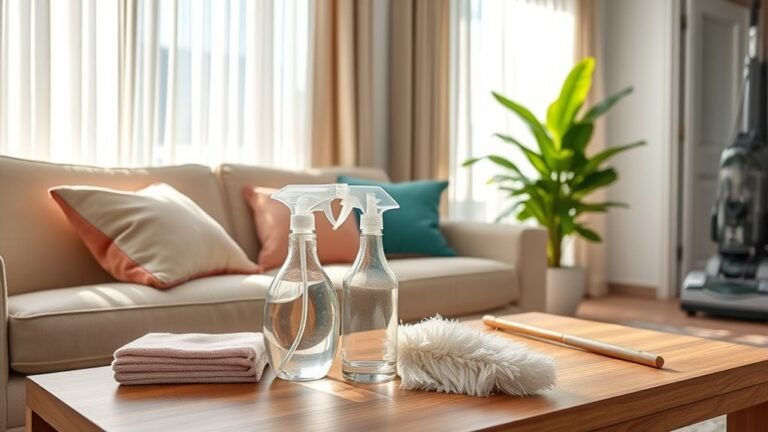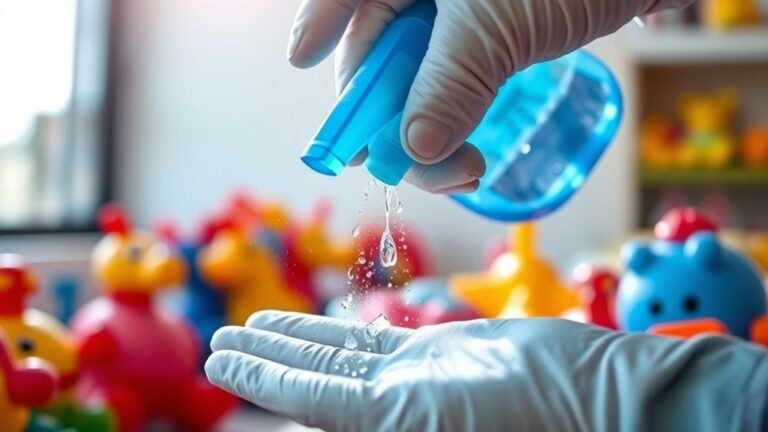DIY Cleaner for Dust
You can create an effective DIY dust cleaner using distilled water, white vinegar, and a few drops of essential oil for scent and antibacterial benefits. Mix one cup distilled water with a tablespoon of vinegar and 5-10 drops of your favorite oil. Apply the solution to a microfiber cloth, then dust from top to bottom with gentle strokes to trap particles without damage. This natural mix is safe, affordable, and eco-friendly. Keep going to discover tips for maintaining a cleaner, dust-free home.
Ingredients Needed for Homemade Dust Cleaner

To make an effective homemade dust cleaner, you’ll need a few simple, readily available ingredients that work together to trap and lift dust efficiently. Start with eco friendly ingredients like distilled water, which prevents streaks and buildup. Add a small amount of white vinegar for its natural cleaning power and mild acidity that breaks down dust particles. Incorporating a few drops of essential oils not only adds a pleasant scent but also enhances the cleaner’s antimicrobial properties. To guarantee your mixture works at peak performance, maintain effective ratios: typically, one cup of distilled water to one tablespoon of vinegar and 5-10 drops of essential oil. This precise balance maximizes dust removal without leaving residue or harming surfaces, giving you a reliable, environmentally responsible dust cleaner you can trust.
Step-by-Step Guide to Mixing Your Dusting Solution
Mixing your dusting solution involves just a few straightforward steps that guarantee the ingredients combine effectively for best performance. Start by measuring your base—usually water or a mild liquid cleaner—according to the recommended mixing ratios. Next, add a small amount of oil, such as olive or mineral oil, which helps trap dust. Then, incorporate essential oils not only for a pleasant scent but also for added antibacterial properties; typically, 10-15 drops per cup of liquid work well. Stir the mixture gently but thoroughly to verify even distribution. Finally, transfer your solution to a spray bottle for easy application. Following these precise steps assures your DIY dust cleaner is both effective and safe, giving you freedom from commercial chemicals while maintaining a spotless space.
Best Practices for Using Your DIY Dust Cleaner

Although your DIY dust cleaner is effective, using it correctly assures prime results and prevents residue buildup. For effective application, always apply the solution to a microfiber cloth rather than directly onto surfaces. This prevents oversaturation and streaks. Adopt systematic dusting techniques—start from higher surfaces, like shelves and ceiling fans, working downward to avoid redistributing dust. Use gentle, consistent strokes to capture particles without scattering them. Avoid excessive pressure, which can damage delicate items. Remember to frequently rinse or replace your cloth to maintain cleaning efficiency. By following these guidelines, you guarantee your DIY cleaner performs at its best, leaving surfaces spotless and residue-free. This methodical approach not only maximizes your cleaner’s potential but also supports your desire for a clean space on your own terms.
Tips for Maintaining a Dust-Free Home Naturally
Maintaining a dust-free home naturally goes beyond effective cleaning techniques; it requires adopting habits and environmental controls that minimize dust accumulation. You can achieve this by using eco friendly materials and committing to regular cleaning routines. Here are essential tips to help you maintain a cleaner environment:
| Action | Frequency | Benefits |
|---|---|---|
| Dust with microfiber cloths | Weekly | Traps dust without spreading |
| Use air purifiers | Continuous | Reduces airborne particles |
| Wash bedding in hot water | Biweekly | Eliminates dust mites |
Benefits of Using Natural Dust Cleaners Over Commercial Products

Choosing natural dust cleaners over commercial products offers several advantages that directly impact your health and home environment. When you opt for natural solutions, you reduce exposure to harsh chemicals often found in commercial cleaners, promoting significant health benefits like fewer respiratory irritations and allergies. Additionally, natural cleaners typically contain biodegradable ingredients, lessening the environmental impact by decreasing water and soil pollution. This choice aligns with your desire for freedom from toxic substances and supports sustainable living. By making your own dust cleaner, you control what goes into your home, ensuring safety for you and your loved ones. Furthermore, natural alternatives often cost less and use readily available materials, empowering you to maintain a clean, healthy space without compromising the planet’s well-being.
Frequently Asked Questions
Can This DIY Cleaner Be Used on Electronic Screens?
You’ll want to be cautious when using any cleaner on electronic screens to guarantee electronic safety. Not all cleaners are suitable for screen cleaning because harsh chemicals can damage the display. Instead, opt for a mild solution like diluted isopropyl alcohol or specialized screen cleaners. Always apply the cleaner to a microfiber cloth first, never directly on the screen, to avoid moisture seeping into the device and compromising its function.
How Long Can the Homemade Dust Cleaner Be Stored?
Oh sure, you can keep that homemade cleaner forever—if you enjoy mystery science experiments. Realistically, its shelf life is about one to two weeks. For best storage tips, keep it in a sealed spray bottle, away from direct sunlight and extreme temperatures. This method preserves its effectiveness and lets you clean freely without worrying about it spoiling. Remember, fresh is best when it comes to DIY cleaners.
Is This Cleaner Safe for Pets and Children?
You’ll want to prioritize pet safety and children safety by confirming the cleaner uses non-toxic, natural ingredients like vinegar and water. Avoid harsh chemicals, which can be harmful if ingested or inhaled. Always store the cleaner out of reach to prevent accidental exposure. Test a small area first to confirm it won’t irritate sensitive skin or respiratory systems. Taking these steps lets you clean freely without worrying about your loved ones’ health.
Can Essential Oils Be Added for Fragrance?
Think of essential oils as tiny messengers carrying the fragrance benefits of nature’s freedom. Yes, you can add essential oils to your cleaner to infuse a pleasant scent, but you’ll want to use them sparingly—usually just a few drops—to avoid overpowering the mixture. Choose oils known for safety, like lavender or eucalyptus, ensuring they complement both your cleaner’s effectiveness and your desire for a fresh, natural aroma without compromising safety.
Does the Cleaner Work on Fabric Surfaces?
You’ll find the cleaner’s fabric effectiveness depends on the material type and cleaning technique you use. For delicate fabrics, test a small area first to avoid damage. Lightly mist the surface and gently blot or vacuum to remove dust. Avoid saturating fabric to prevent moisture buildup. With proper technique, this cleaner can refresh upholstery and curtains efficiently, giving you freedom to maintain your fabrics without harsh chemicals or heavy scrubbing.






